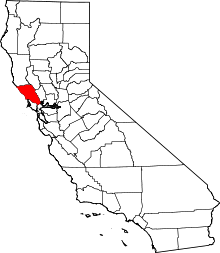Graton Rancheria
| Graton Rancheria | |
|---|---|
| Indian reservation |
The Graton Rancheria was a 15.45-acre (62,500 m2) property in the coastal hills of northern California, about two miles (3 km) northwest of Sebastopol. Its current address is 10091 Occidental Road, Sebastopol, California. The site is about 1.5 miles (2.4 km) southwest of the hamlet of Graton, population 1,815 in 2000.[1] The area is a few miles west of Santa Rosa, the largest of Sonoma County's nine cities and the County seat, population 147,595 in 2000.[2] It was a former rancheria for Central Coast and Central valley tribes, including the Southern Pomo, a Hokan-speaking tribe,[3] and Coast Miwok.[4]
History
Due to the influx of non-Native settlers in California beginning in the mid-19th century, many California Indians were displaced from their traditional homelands. Several California tribes signed treaties with the United States in 1851 which promised lands to the tribes; however these treaties were never ratified and many California tribes were left completely landless. In 1901, the United States Congress passed several laws, known as the Homeless Indian Acts. These paved the way for the establishment of Indian colonies and rancherías in California, which were purchased lands for area Indians.[5] A ranchería, the Spanish term for Indian village, is a small plot of land reserved for area Native Americans, usually only large enough for residences and gardens.[6]
Bureau of Indian Affairs inspector John J. Terrell tried to secure coastal lands for the Coast Miwok but found the costs prohibitively expensive. He then purchased lands inland for the "homeless and landless Indians of the Marshall, Bodega, Tomales, and Sebastopol areas."[5]
75 Native Americans tried to move onto the lands in 1920; however, they discovered only three acres of the rancheria were habitable.[7]
Prior to 1921, the hilly and heavily timbered 15.45-acre (62,500 m2) property, consisting of 3 small tracts, was the private property of Joseph and Louisa Corda.[8] This land was put into federal trust; however, it proved inadequate for settlement, due to an inadequate water supply and steep terrain that afforded little space for building houses. The rancheria was located far from available jobs.[5]
Termination
By 1954, the Eisenhower administration identified forty-four California Indian tribes or rancherias for termination, that is, unilaterially ended federal trust relationship with the Native groups in order to facilitate assimilation into mainstream society.[9] The Graton Ranchería was terminated by the US in 1958.[10]
After termination, Frank Truvido retrained an acre of the former ranchería. He had to sell other land to pay taxes. After Truvido's death, his land and house went to his daughter.[4]
Greg Sarris, Chairman of the modern Federated Indians of Graton Rancheria, speaking to Congress on May 16, 2000, said:
- "In 1958 when they came by and did a census at the height of the harvest season, when no one was around, they found three families and with the Rancheria Termination Act, offered those three families or three designees, the right to buy the land, and, in essence, terminate the rancheria as trust land.... (and) without the vote or the consensus of the rest of the members."[11]
The Point Reyes Light quoted Sarris, saying "Congress...dissolved federal recognition of the tribe in 1958 after deciding wrongly that all the Rancheria’s members were dead."[10]
The Federated Indians of Graton Rancheria
The Federated Indians of Graton Rancheria, formerly the Federated Coast Miwok, takes its name from the Graton Rancheria. The federally recognized tribe of Coast Miwok and Southern Pomo Indians re-established its status in 2000.[10]
FIGR Chairman Greg Sarris testified before the House Resource Committee that "15.45 acres were purchased in Graton for our members. Seventy-five members moved on in 1920."[12]
On April 18, 2008, the tribe was able to acquire 254 acres (1.03 km2) of land.[13]
Casino
Graton Rancheria is the site of the Graton Resort & Casino, which opened in November 2013. The casino is actually near Ronhert Park, not Graton as stated above...
Notes
- ↑ U.S. Census
- ↑ "Santa Rosa City, California Statistics and Demographics (US Census 2000)." Area Connect. (retrieved 23 Feb 2010)
- ↑ Eargle, California Indian Country, 88
- 1 2 Eargle,Native California Guide, 137
- 1 2 3 A. The Establishment of the Graton Rancheria..." Federated Indians of Graton Rancheria. 2004. (retrieved 7 Jan 2009)
- ↑ Eargle, California Indian Country, 68
- ↑ "Hearing on HR 946, HR 2671, and HR 4148." Oversight Hearing before the Committee on Resources, House of Representatives 106th Congress, 2nd Session. Serial No. 1060995. 16 May 2000 (retrieved 7 Jan 2009)
- ↑ As recorded in both a July 6, 1920 Department of the Interior letter, and in the records of the County of Sonoma, Book 310, page 180
- ↑ "XIV. Status and Needs of Unrecognized and Terminated California Indian Tribes: Termination." University of California, Los Angeles: American Indian Studies Center. (retrieved 6 Jan 2009)
- 1 2 3 Foley, Gregory. "US Senate approves recognition of Coast Miwok." Point Reye Light. 14 Dec 2000 (retrieved 6 Jan 2009)
- ↑ "H.R. 946, H.R. 2671, and H.R. 4148 (YOUNG, R09AK): Oversight Hearing." U.S. House of Representatives Committee Hearings. 16 May 2000 (retrieved 6 Jan 2009)
- ↑ "Tribal Contract Support Cost Technical Amendments of 2000" to HR 946, HR 2671, and HR 4148." 106 Congress House Hearings: From the US Government Printing Office via GPO Access. 16 May 2000 (retrieved 6 Jan 2010)
- ↑ "Land Acquisitions; Federated Indians of Graton Rancheria, California." Federal Register (Volume 73, Number 89). 7 May 2008 (retrieved 6 Jan 2009)
References
- Eargle, Jr., Dolan H. California Indian Country: The Land and the People. San Francisco: Tree Company Press, 1992. ISBN 0-937401-20-X.
- Eargle, Jr., Dolan H. Native California Guide: Weaving the Past and Present. San Francisco: Tree Company Press, 2000. ISBN 0-937401-10-2.
External links
Coordinates: 38°24′59.32″N 122°52′58.89″W / 38.4164778°N 122.8830250°W
